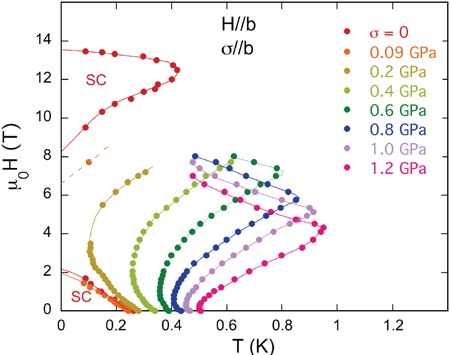The microscopic coexistence of ferromagnetic order and superconductivity in several uranium based compounds is a major discovery in which
our laboratory has played a leading role. The survival of Cooper pairs in the strong ferromagnetic exchange field can only be understood if the electrons forming a pair can have parallel spins (triplet superconductivity). Moreover from the beginning it was strongly suspected that the ferromagnetic fluctuations were actually at the origin of the pairing mechanism: this has now been confirmed by one theoretical and two experimental studies in our institute, making these systems the first unconventional superconductors where we are close to a quantitative description of the pairing mechanism.
The first study was able to explain the spectacular anisotropy of the upper critical field in UCoGe, whereas this compound has rather isotropic electronic properties in its normal state
[1]. We have shown that this anisotropy stems from the strong suppression of the pairing strength when the applied field is aligned with the easy ferromagnetic axis. We have established a quantitative relation between this, and the suppression of the ferromagnetic fluctuations and the electronic correlations. A further step has now been made in the fine understanding of the pairing mechanism through a set of experiments on the compound
URhGe under uniaxial stress[2]. The behaviour under magnetic field of this system was already known to be quite remarkable: when a magnetic field is applied along the b-axis (perpendicular to the easy c-axis), superconductivity is initially destroyed as is normal in any superconductor. However as the field is further increased, superconductivity reappears, and the maximum superconducting critical temperature is achieved for a field of about 12T ! Applying uniaxial stress we have found that this field decreases strongly and that the two superconducting pockets merge (Figure). Simultaneously the critical temperature increases significantly, both at zero field and under field. We have found that this reinforcement of superconductivity is correlated to the increase of the magnetic susceptibility along the b-axis, perpendicular to the easy axis, showing that the transverse fluctuations are favourable for superconductivity. This is in contradiction with the initial theoretical models for ferromagnetic superconductors, but is in agreement with the predictions
of a recent theoretical study in our laboratory, showing that these ferromagnetic superconductors must be considered as « multiband » superconductors
[3]. In this case, the inter-band coupling (carried here by the transverse ferromagnetic fluctuations) enhances the critical temperature. This effect is predicted for all multiband superconductors like the iron based pnictides or MgB2, though it has never been tested as directly as in the present study.

Figure: (T-H) phase diagram of superconductivity in URhGe for different values of uniaxial stress applied along the b-axis. The magnetic field is also applied along the b-axis. The c-axis is the easy ferromagnetic axis.
The experimental studies are carried out on single crystals grown by the Czochralski technique in a tetra-arc furnace within PHELIQs. The measurement under stress is performed in a new device allowing the in situ application of uniaxial stress in a dilution cryostat with a magnetic field up to 8T, and the upper critical field anisotropy was determined by thermal conductivity measurements in a dilution cryostat with 2-axis
in situ rotation and a maximum field of 15T.
These studies were made with financial support from the ERC project of Dai Aoki (NewHeavyFermion) and the ANR projects « SINUS » and « PRINCESS ».